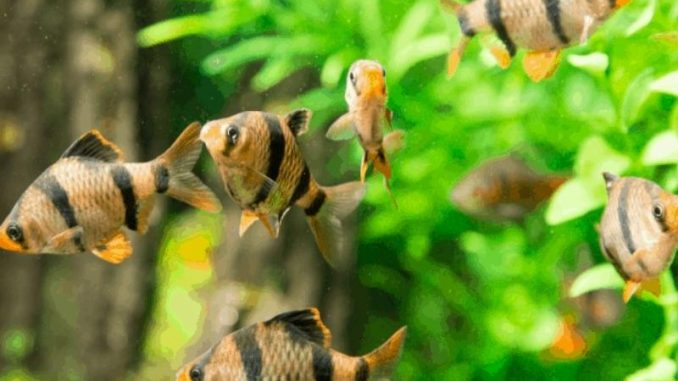
Barbs are a group of colorful, lively freshwater fish from the carp family, Cyprinidae. There are more than 2,000 known types of barb species native to Africa, Asia, Europe, and South America.
Barbs are active and lively, and come in a range of beautiful colors, making the fish a striking addition to any community tank.
TABLE OF CONTENTS
Barb Facts & Overview

| Scientific order: | Cyprinidae |
| Common names | Barb |
| Distribution: | Europe, northern Africa, and central and Southeast Asia |
| Size: | 1–13 inches, depending on the species of barb |
| Life expectancy: | 5–7 years |
| Color: | A variety of colors, including yellow, silver, gold, black, red, pink, purple, blue, and green |
| Diet: | Omnivore |
| Temperament: | Peaceful, can be playful and occasionally aggressive |
| Minimum tank size: | 20–55 gallons, depending on the species of barb |
| Temperature: | 64–82°F |
| pH: | 6.0–8.0 pH |
| Hardness: | Less than 10 dGH |
| Care level: | Easy–moderate |
| Breeding: | Egg-layer |
Origin & Distribution
The name “barb” comes from the Latin word barba meaning “beard.” Barbs are named for the beard-like barbels around the fish’s mouths. This feature gives barbs the nickname “freshwater shark“.
Barbs are found in fast-flowing waters and lakes in subtropical environments, including Africa, Europe, Asia, and North America.
Types of Barbs & Appearance
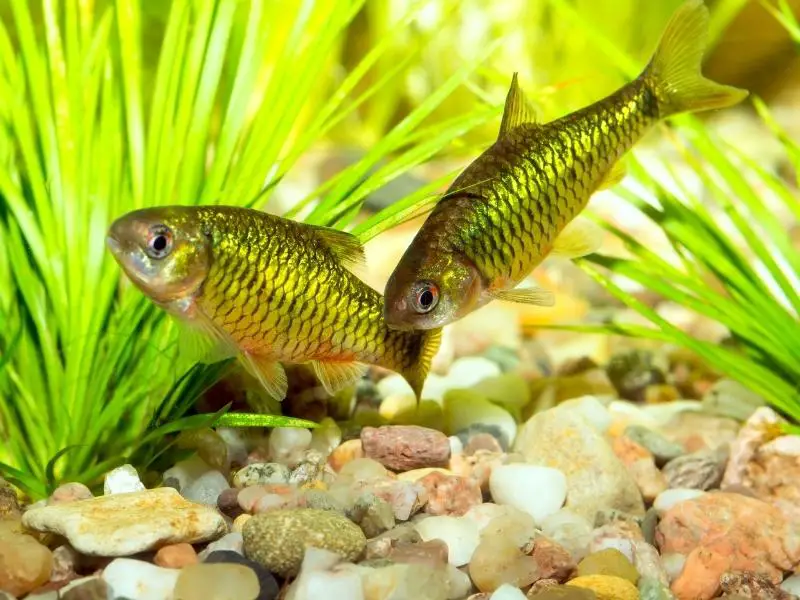
There are more than 2,000 barb species. The fish vary widely in size, with the smallest barbs reaching one inch when fully-grown, and the biggest barbs growing up to six inches long.
Some of the most popular types of barbs amongst aquarists are listed below.
Tiger Barb
Tiger barbs are small fish with silver bodies, orange- or red-tipped fins, and four vertical tiger-like stripes. Adult fish reach 3 inches in length. They tend to nip fins, so they are unsuitable for aquariums with long-finned fish. Tiger barbs prefer to live in a large school.
Cherry Barb
Cherry barbs have vibrant red bodies with brown and orange highlights. Males are particularly vibrant during spawning season. These fish enjoy being in small schools of up to six barbs, and they are peaceful community fish. Adult cherry barbs reach 2 inches in length.
Denison Barb
Denison barbs are one of the largest barb species, reaching 6 inches in length. They are silvery-gray with black and red horizontal stripes spanning from the mouth to the tail. Due to this stripe, they’re also known as bleeding eye barbs. Keeping Denison barbs with similarly-sized fish is best.
Gold Barb
Named for their coloring, gold barbs are gold with yellow hues and black spots. They reach 3 inches when fully grown. Gold barbs are hardy community fish with low care needs, although they prefer to live in schools of six or more. They can be housed with peaceful non-barb tank mates.
Rosy Barb
Rosy barbs have gold bodies with a rosy pink/orange hue. They reach 6 inches when fully grown. These barbs are tolerant of a variety of water conditions and can live in a newly established aquarium. However, they have a reputation for fin-nipping, so they shouldn’t live alongside long-finned, slow-swimming fish.
More Types of Barbs
Although the barbs above are popular, there are plenty of other interesting types of barbs that could be added to a home aquarium:
- Black ruby barbs: Peaceful fish with deep red bodies and transparent tails. Easy to care for when kept in schools of five or more. Also known as purplehead barbs. Reach up to 2.5 inches when fully grown.
- Spotted barbs: Greenish or silvery-gray with pale or white throats and bellies and a black spot on the caudal base. Peaceful fish that reach up to 4 inches in length. Easy to look after when placed in the right tank environment resembling a slow-flowing stream or river. Otherwise known as spotted barbs or big-spot barbs.
- Snakeskin barbs: Orange-yellow bodies with red accents and python-like black markings. Reach 3.5 inches when fully grown. Peaceful, orderly fish that do well in a community tank. Also known as rhombo or orange buffalo barbs.
- Zebra barbs: Peaceful and attractive, with silver bodies and horizontal gray stripes running from the gills to the tail. Active schooling fish that reach 4.25 inches as adults. Rarely for sale.
- Tinfoil barbs: Silver with yellow accents and orange-red-tipped fins and tail. The largest barb species available, reaching up to 13 inches. Require a 55-gallon tank with plenty of room to swim. Peaceful, should only be kept with other large fish.
- Ticto barbs: Otherwise known as two-spot barbs. Peaceful, active fish with silver and gold bodies and two black spots: one near the back tail and one just before the pectoral fin. Schooling fish that won’t bother other fish when kept in groups of at least five.
- Fiveband barbs: Resemble tiger barbs, except fiveband barbs have five black stripes, not four. Grow to a maximum length of 3.5 inches. Harmless schooling fish that do best in well-planted environments with at least four other fish of the same species.
- Spanner barbs: Elongated fish with pale yellow bodies and three vertical black lines, along with a spot above the anal fin. These colors fade as the fish get older. Peaceful, beginner-friendly fish that can grow up to 6 inches in length.
Barb Behavior & Compatibility
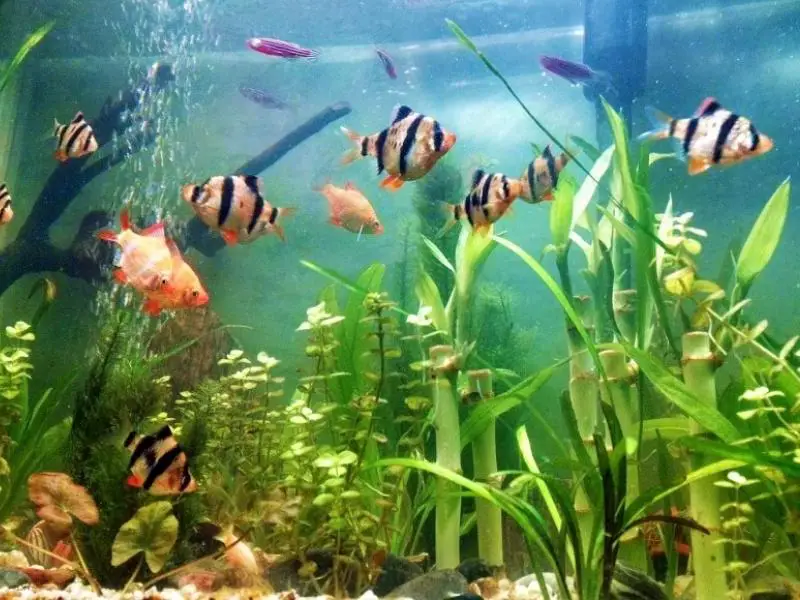
Barbs are peaceful, active fish that swim in groups in the middle of the tank. Some barbs, like rosy barbs and tiger barbs, are fin-nippers, and you shouldn’t house these fish with slow-moving, long-finned fish.
Although barbs are peaceful, these fish display showy behavior and form hierarchies in the aquarium. Barbs enjoy swimming in the open, and this fish group is entertaining to watch. Many barb species bump and bite other fish, but this behavior is harmless.
Buying schools of at least five barbs for your tank is important. If barbs are kept alone, or in small groups of less than five, the fish are more likely to become stressed and harass other tank mates.
Tank Mates
First and foremost, barbs need to be housed in groups of the same species. Before considering adding different fish to your tank, make sure you have at least five of the same barb species. The fish can become lonely, stressed, and aggressive without tank mates of their kind.
Aside from other barbs, you can house barbs with any peaceful, similarly-sized fish that don’t have long, flowing fins. Many barb species have fin-nipping tendencies, and housing barbs with long-finned fish will encourage this behavior.
If possible, add barbs to the tank first, and add other fish at a later date. When barbs are added to the tank first, the fish are less likely to be aggressive towards their tank mates.
Some of the most suitable tank mates for barbs are:
- Loaches — Clown loaches and kuhli loaches are peaceful bottom-dwelling fish that don’t like to cause trouble. Clown loaches are appealing to aquarists because the fish are active during the day. Both loach species do best in schools of six or more.
- Tetras —The least aggressive and territorial tetras are cardinal tetras and neon tetras. These tetras are ideal barb tank mates because the fish won’t respond aggressively to a barb’s playful behavior. Neon tetras and cardinal tetras reach 1.5 inches long, so these fish should only be housed with small barbs.
- Corydoras —Peaceful, bottom-dwelling fish, corydoras keep to themselves and prefer to live in schools of five or more. Corydoras are another small fish species, reaching 2.5 inches when fully grown. You should house corydoras with similarly-sized barbs.
- Plecos — Otherwise known as suckermouth catfish, plecos are beautiful, peaceful tank mates for barbs. Plecos have sociable temperaments and rarely show aggression to other fish. You’ll need a big tank to house common plecos because these fish grow up to 15 inches in captivity.
- Pictus — The pictus catfish has a unique appearance, with whiskers, a forked tail, and a downturned mouth. Pictus catfish are energetic but peaceful, non-territorial fish. You should house pictus catfish with barbs that are at least three inches long because pictus catfish are known to eat small fish.
- Mollies — Docile, beautiful, and easy to care for, mollies are ideal tank mates for barbs. Male mollies can behave aggressively toward one another, and you should house a single male with a group of females to prevent this. Mollies can be kept singularly or in groups, and grow up to six inches long.
Male vs Female Barbs
Female barbs are paler and less colorful than males. Some species of female barbs, like tiger barbs, grow bigger than the males. Female barbs have rounder bellies than males, especially during spawning season.
There are specific color differences between male and female barbs, depending on the species. For instance, male rosy barbs have darker fins than female rosy barbs. Male tiger barbs have redder noses than females. Female cherry barbs are dull red, orange, or brown, while male cherry barbs take on a bright red color.
Male barns are more aggressive, showy, and dominant than females. This behavior shouldn’t affect the fish’s care, but you should avoid buying a school of only male fish and keep an eye on any male barbs in the tank.
Barb Tank Setup
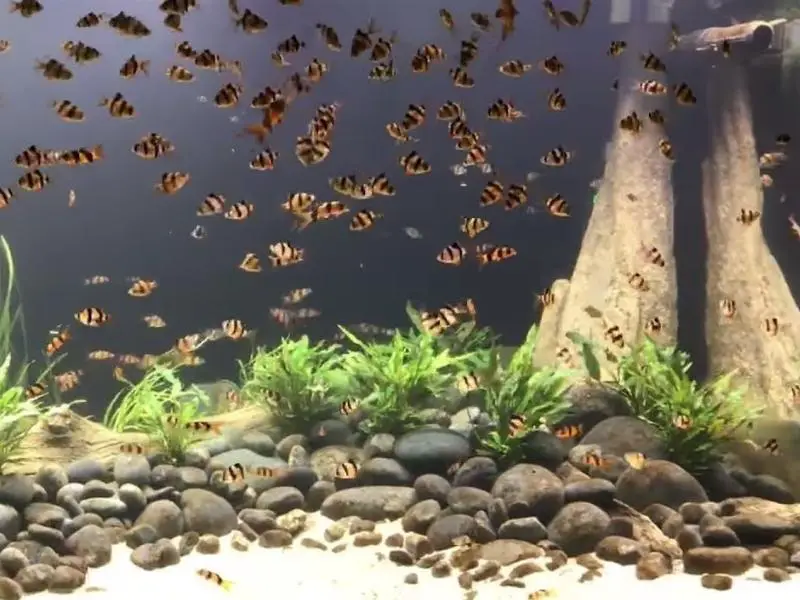
Barbs are freshwater fish that are used to shallow, murky waters with algae and decaying plant material. Looking after barbs is easy because the fish are tolerant to a range of water parameters.
Tank Size
You should choose a suitable tank size based on the size of the barbs you’re housing. Barbs that grow to 1–3 inches require a minimum tank size of 20–25 gallons. Barbs that grow beyond 10 inches need a tank size of at least 55 gallons.
If you plan to house barbs with other fish, the tank should be large enough to accommodate all fish.
Barbs are a fraction of their full size when you buy the fish as juveniles from a pet store. For instance, tinfoil barbs grow up to 13 inches, but these fish are only 3 or 4 inches in length as juveniles. Make sure you know how big a barb will grow before you bring the fish home to avoid a new tank purchase later on.
Water Temperature, Hardness, and pH
Although barbs are hardy, the fish still require consistent water parameters to stay healthy. Each barb species has its preferred water conditions. Below is a broad overview of the tank parameters you should aim for.
- The water temperature should be 64–82°F.
- The pH should measure between 6 and 8.
- Water hardness should be less than 10 dH.
When buying a barb species, look for this fish’s specific water temperature, pH, and hardness requirements and prepare your tank in advance.
Barbs enjoy a strong water current, so you should install a powerful filter in your aquarium for maintaining water flow.
Care
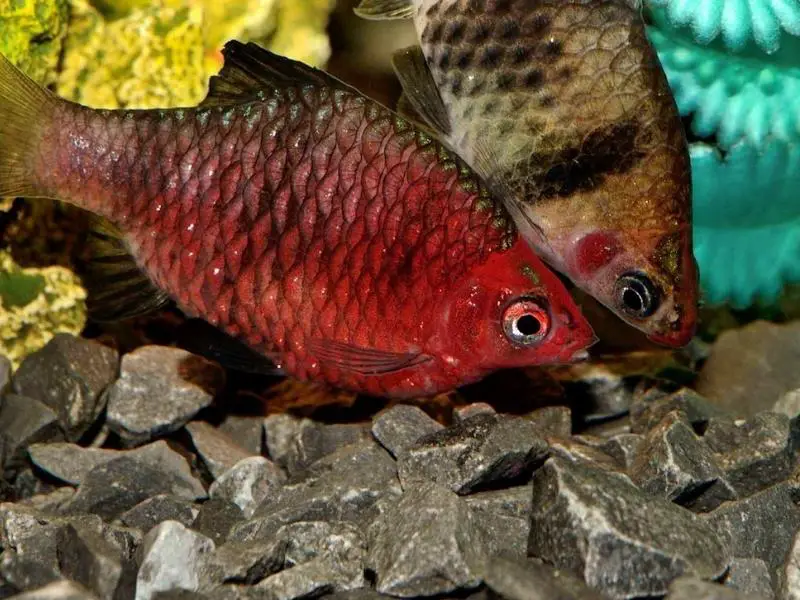
Barbs are hardy fish that aren’t susceptible to many diseases. These beginner-friendly fish are easy to care for, as long as optimal tank conditions are maintained.
Keeping the tank clean will prevent diseases from spreading. You should be prepared to perform weekly water changes before buying barbs for your aquarium.
You should also take care not to overfeed barbs because overfeeding can cause bloating and swimming bladder disease.
Diet & Feeding
Barbs are omnivorous, opportunistic eaters, meaning the fish will take whatever food they can get. You should provide your barbs with a varied diet to replicate the foods the fish eat in the wild.
Live or frozen foods like bloodworms and brine shrimp are highly-nutritious foods that you can feed to barbs once or twice a week. Barbs eat plant matter in the wild, and you can replace this with green vegetables like lettuce and zucchini.
Fish flakes and pellets are enhanced with a range of nutrients, making these foods suitable for everyday feeding.
To prevent overfeeding, feed your barbs enough food for the fish to eat in two minutes, twice per day, and remove any leftover food after this time.
Disease
Although barbs are hardy fish, poor tank conditions can still result in disease. Some of the diseases that affect barbs are listed below.
Ich
Ich (white spot disease) is one of the most common tank diseases, caused by an ectoparasite and characterized by white spots on the fish’s body and fins. It is linked to poor tank conditions and can spread to barbs from new fish added to the tank. To treat ich, quarantine the affected fish in a separate tank and increase the water temperature by two degrees to speed up the life cycle of the parasite.
Swim Bladder Disease
Because barbs are opportunistic eaters, the fish will overeat if given the chance, leading to constipation. Constipation often leads to swim bladder disease, a disorder that causes the fish to float upside down or swim awkwardly. To treat a fish with swim bladder disease, don’t feed the fish for three days and restart feeding with small amounts of de-shelled peas.
Fin Rot
Fin rot is caused by a bacterial infection brought on by poor diet, stress, or poor-quality water conditions. A barb with fin rot will have black or brown, frayed fin edges, and inflamed fin bases. To treat fin rot, perform a water change and check that the filter is working as it should. Use antibiotics or antifungal medication as recommended by your veterinarian.
Breeding Barbs
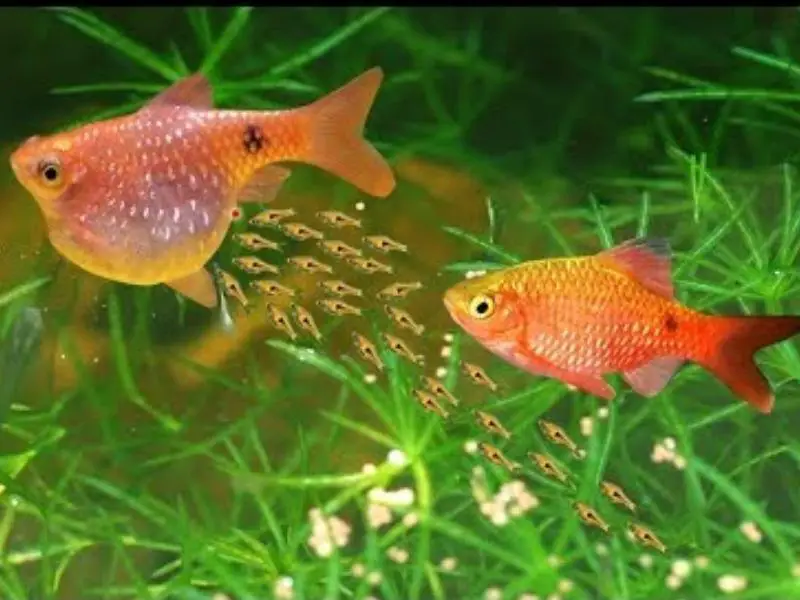
Barbs reach maturity at around 7 weeks of age. In the wild, barbs choose a different mate for each spawning.
It’s easy to breed barbs with the right conditioning and tank setup.
To breed barbs, follow the steps outlined below:
- Condition a healthy male and female barb in separate tanks, feeding the fish three times a day. Foods like brine shrimp and bloodworms are good for conditioning.
- Prepare a breeding tank for the barbs. The tank should have plenty of underwater grasses and reeds, and the water should be clean.
- Place the conditioned male and female barb in the same tank. The male should have more intense colors and the female should have a rounder belly.
- If the barbs are interested in breeding, the pair will spawn under the vegetation, producing hundreds of eggs at a time.
- Remove the male and female when spawning is finished to prevent the parents from eating the eggs.
- Wait up to 48 hours for the eggs to hatch, and up to five more days for the larvae to eat the yolk sacks. Feed the larvae larval brine shrimp for the next 2 or 3 days, then switch to commercial fish fry food.
Should You Get a Barb for Your Aquarium?
You should get a barb if you can house a group of at least four barbs in a peaceful planted tank. Barbs are also great for beginner aquarists, or species-specific tanks.
However, you shouldn’t get a barb if your home aquarium already houses long-finned fish, or if the other fish in a community tank have specific dietary requirements.
Barbs are colorful, active, and lively, making the fish a popular choice for fishkeepers. They would be a low-hassle addition to a home aquarium.

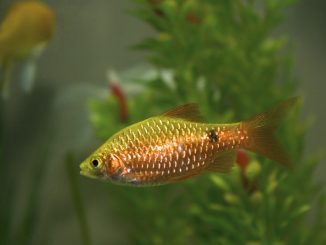
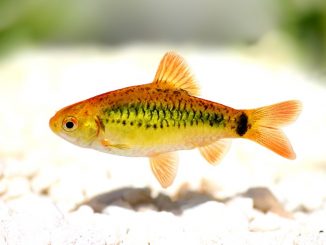
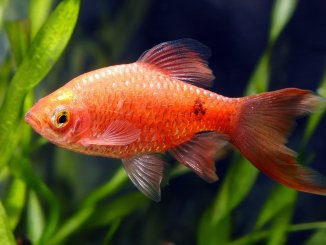
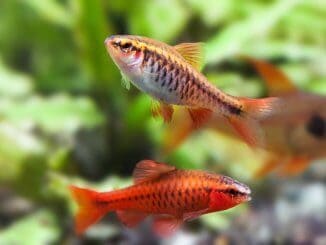
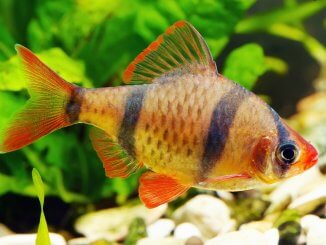

Be the first to comment